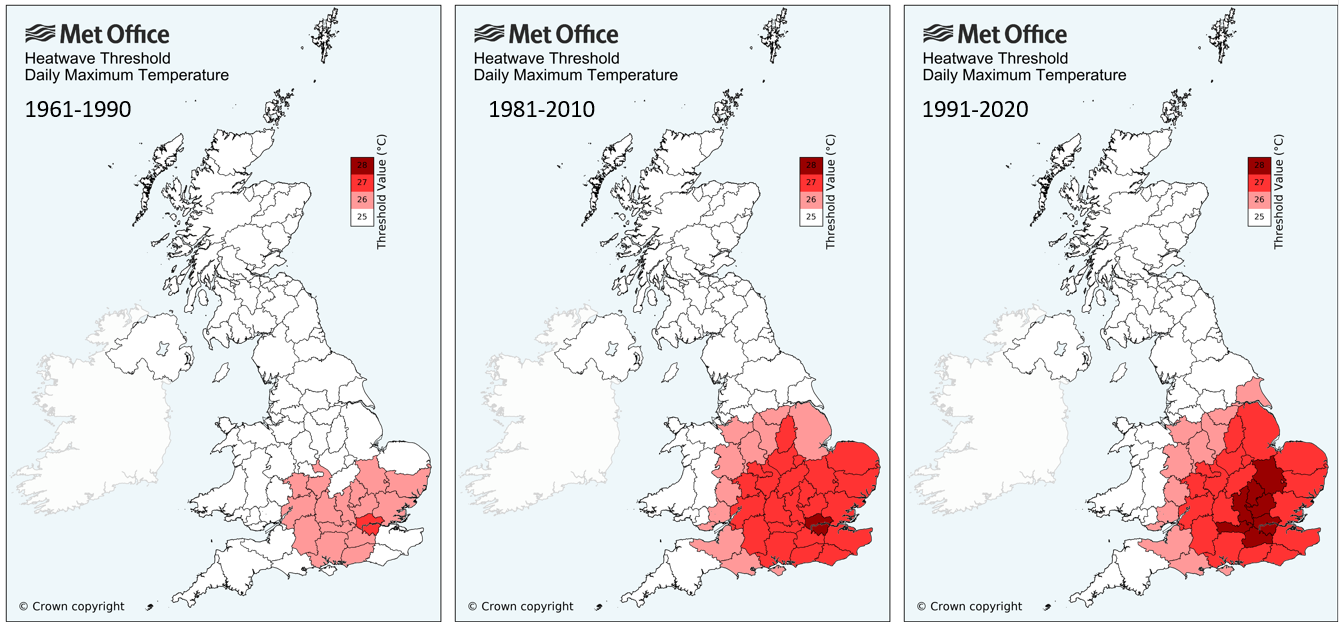UK Climate Change in action
Author: Press Office
00:15 (UTC+1) on Tue 29 Mar 2022
Met Office heatwave thresholds are to be updated ahead of Summer 2022 as the UK sees impacts due to climate change.
Warming across the country has, however, not been even with some regions experiencing more rapid change than others. Heatwave thresholds in 8 counties in a band from Surrey to east Yorkshire are now changing.
Dr Mark McCarthy is the head of the Met Office National Climate Information Centre, which manages the UK’s climate records. He said: “Climate statistics over time reveal an undeniable warming trend for the UK. Temperature rise has been greatest across parts of central and eastern England where they have increased by more than 1.0°C in some locations, while further north areas of Scotland and Northern Ireland have seen temperatures rise by closer to 0.7°C.”
The original heatwave thresholds were based on a reference climate period for 1981-2010. The heatwave definition was intended to be flexible and to be reviewed and revised in order to follow our changing climate and represent heatwaves relative to the “current” climate. Therefore the thresholds are moving to the most recent 1991-2020 climate averaging period introduced in January this year. 6 counties are moving from a 27°C threshold to 28°C, one from 26 to 27°C, and one from 25 to 26°C.

The central map above shows the original thresholds, the right hand one the updated thresholds and, as an additional demonstration of our changing climate, the left hand one shows what they would have been if we had had this definition in place for 1961-1990.
Counties changing from a 27C to a 28C threshold:
Surrey, Berkshire, Buckinghamshire, Bedfordshire, Hertfordshire, Cambridgeshire
Counties changing from a 26C to a 27C threshold:
Lincolnshire
Counties changing from a 25C to a 26C threshold:
East Riding of Yorkshire
Dr McCarthy added: “Although heatwaves are extreme weather events research shows that climate change is making these events more likely. A scientific study by the Met Office into the Summer 2018 heatwave in the UK showed that it was 30 times more likely to occur now than in 1750 because of the higher concentration of carbon dioxide (a greenhouse gas) in the atmosphere. As greenhouse gas concentrations increase heatwaves of similar intensity are projected to become even more frequent, perhaps occurring as regularly as every other year.”
You can find out how climate change is affecting where you live on a joint Met Office and BBC website examining the UK's changing climate.
Met Office heatwave threshold
A UK heatwave threshold is met when a location records a period of at least three consecutive days with daily maximum temperatures meeting or exceeding the heatwave temperature threshold. The threshold varies by UK county.
Find out more about staying prepared for summer weather on our WeatherReady Advice page, there are practical steps you can take to keep homes cool during the day and you can stay up to date on the latest forecast on the Met Office website or download the Met Office app.





